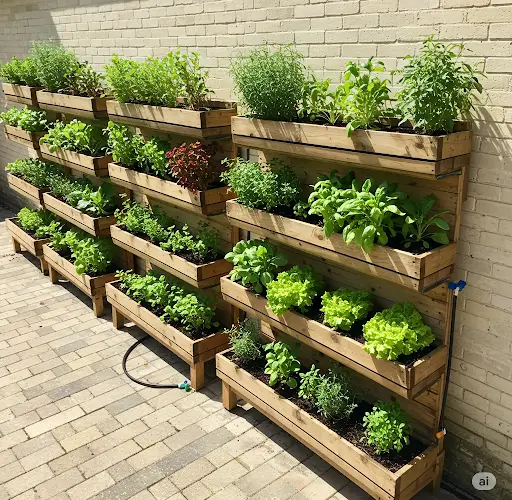Vertical vegetable gardening is a smart, space-saving technique that enables anyone—from city dwellers with balconies to homeowners with small yards—to grow fresh produce upward instead of outward. Whether you’re short on space or simply want a more organized and productive garden, vertical gardening offers a wealth of benefits when implemented correctly.
In this guide, you’ll learn how to set up a vertical garden, which vegetables thrive in vertical systems, and essential tips for success throughout the growing season.
Why Grow Vegetables Vertically?
Growing vegetables vertically has several key advantages:
-
Space Efficiency: Perfect for small gardens, patios, and balconies, vertical setups let you grow more food in less area.
-
Improved Air Circulation: Lifting plants off the ground reduces humidity and prevents fungal diseases like powdery mildew and blight.
-
Easier Harvesting and Maintenance: Fruits and vegetables are more accessible and visible, making them easier to harvest and care for.
-
Fewer Pest Problems: Keeping plants off the ground helps protect them from crawling pests like slugs and snails.
-
Aesthetic Appeal: Vertical gardens can double as living walls, trellised borders, or green privacy screens.
Ideal Vegetables for Vertical Gardening
Not all vegetables are suited for vertical growth, but many varieties thrive when given proper support. Here are some excellent candidates:
-
Climbing Vegetables: Pole beans, peas, cucumbers, and some squash varieties naturally climb and need trellises or netting.
-
Vining Tomatoes: Indeterminate tomato varieties grow best with vertical support and regular pruning.
-
Compact or Trellis-trained Crops: Zucchini, eggplant, and peppers can be trained vertically with cages or stakes.
-
Leafy Greens in Vertical Towers: Lettuces, spinach, and herbs grow well in vertical pocket planters or tiered systems.
Choosing the Right Vertical System
There are many ways to grow vertically, from DIY solutions to commercial kits. Your choice will depend on your available space, budget, and the crops you want to grow.
-
Trellises: Ideal for climbing plants like beans, cucumbers, and tomatoes. Can be made from wood, wire, or plastic netting.
-
Arbors and Arches: Provide both structural support and a decorative touch. Perfect for heavy fruiting vines like gourds or melons (with sling support).
-
Wall Planters and Pocket Gardens: Great for herbs and greens. These mount directly to fences or walls.
-
Vertical Towers: Stackable or rotating planters allow you to grow many shallow-rooted crops in a compact footprint.
-
Hanging Baskets: Ideal for strawberries, trailing herbs, or small peppers.
Building Your Vertical Garden
1. Select a Sunny Location
Most vegetables need 6–8 hours of sunlight daily. Position your vertical structure where it gets maximum exposure—ideally facing south.
2. Prepare the Soil
Use rich, well-draining soil, and consider mixing in compost or organic matter. In containers or towers, choose high-quality potting mix with good aeration.
3. Install Supports Before Planting
Always set up your trellises, cages, or towers before planting. Installing them later can disturb roots and damage tender seedlings.
4. Choose Appropriate Varieties
Look for vining or indeterminate varieties. Many seed packets or labels indicate whether a plant is suitable for vertical growth.
5. Train and Tie Plants
As vines grow, gently guide them toward the support structure. Use soft ties (like twine or cloth strips) to avoid damaging stems.
Tips for Maintaining a Vertical Vegetable Garden
-
Water Regularly: Vertical gardens may dry out more quickly, especially in containers. Water consistently and deeply.
-
Fertilize Wisely: Use a balanced fertilizer every few weeks to replenish nutrients, especially in container-grown plants.
-
Prune and Trim: Remove excess foliage to increase airflow and light penetration. Pruning also helps focus energy on fruit production.
-
Support Heavy Fruits: Use slings made from old fabric or mesh to cradle melons, squash, or tomatoes that grow large and heavy.
-
Rotate Crops Each Season: This prevents nutrient depletion and reduces disease risk.
Dealing with Common Issues
-
Leggy Plants: Insufficient light or crowded conditions can cause spindly growth. Space plants appropriately and ensure they get enough sun.
-
Yellow Leaves or Poor Growth: May signal overwatering, poor drainage, or nutrient deficiency. Check soil and adjust watering or feeding.
-
Fungal Infections: Improve airflow and avoid watering the leaves. Consider applying organic fungicides if needed.
-
Weak Trellises or Supports: Reinforce your structures before vines get heavy, especially after rain or high wind.
Harvesting from Vertical Gardens
Harvest vegetables regularly to encourage continuous production. Pick beans, peas, and cucumbers when young and tender. Tomatoes and peppers should be picked once fully colored. Leafy greens can be harvested using the “cut and come again” method, removing outer leaves and letting inner ones continue growing.
Final Thoughts
Vertical vegetable gardening offers a practical and beautiful way to grow food, even in tight spaces. By choosing the right crops, using appropriate supports, and giving your plants the care they need, you’ll enjoy a lush, productive garden that reaches for the sky.
Whether you’re gardening on a balcony, a patio, or a small backyard, growing upward can transform the way you cultivate your vegetables. With the right techniques, your vertical garden will not only feed your family but also serve as a vibrant and inspiring green space.



